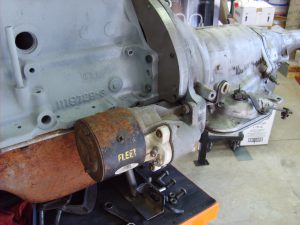This is the often duplicated adapter, designed for the pre-1962 V-8 engines.
The adapter package consists of the block plate/adapter, the crank flange adapter and the needed bolts for the block and the crankshaft. The exact requirements for the fasteners varies with the application. Flexplate and flywheels, although available, are not part of the basic package due to variations in applications.

This is the block adapter mounted to a 392 block.

This is the crankshaft flange adapter.

If using a post-62 flywheel then the crank flange must be tapped for cap screws. The fixture keeps the tap aligned. Do Not attempt to tap the flange freehand. This is required for all pre-1962 engines. Remember, the bolts are there to keep the flywheel out of your lap and bolts on some odd angle will not provide proper clamping force.

This is the Dakota style bellhousing for the AX15 transmission. All manual bellhousings will mount in essentially the same manner, although the required fasteners vary slightly from one design to another.

The Dakota bellhousing requires grinding a slight relief in the edge of the block to clear the head of the socket-head cap screw.


This is the adapter as mounted to a Dodge 230 Flathead 6.

Flathead 6 with AX15 bellhousing attached.

When using a post-62 manual bellhousing behind a 208/218 with the late 143 tooth flywheel the starter must be shifted foreward to account for the shorter crank flange extension. An alternative would be to make a thinner block adapter, however, the number of 208-218 being used does not justify this additional inventory so shims are used to reposition the starter.
This is the starter shim package:

Shim package on bellhousing:

The starter nose must be shortened by the amount of the lead-in chamfer:

When using the late starter and the early style 146T ring-gear then the starter must be moved about 0.040″ away from the ring-gear due to the difference in overall diameter of the 143T (14.6″) vs the 146T (14.65″).
The locating pilot must be trimmed on the outboard side:

Additionally, the top bolt hole must be enlarged to allow the starter to pivot on the bottom bolt and swing away from the ring-gear:

Flathead 6 with an A-904 Torqueflite attached.

When considering transmission swaps into older cars the starter position is often of concern. Note in this picture the relative position of the starter to the block and compare to the available space in your particular vehicle.
If you are using a late model transmission then keep in mind the 12 volt requirements for the starter. Refer to the ‘Electrical’ section for additional details.